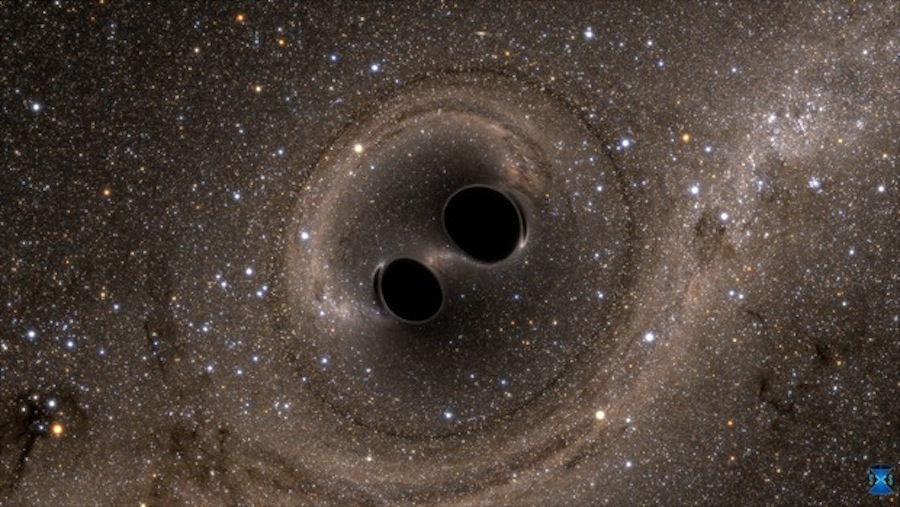
Discovery of astronomical phenomenon makes waves for science community.
For most of the past century, Albert Einstein’s ideas have shaped and transformed the world of physics. His greatest impact on the field was through one of his later works, the theory of general relativity, in which he reimagined everything previously understood about gravity, space and time. Since the publication of his research in 1915, scientists have dedicated their efforts to testing his famed theories and seeing how they hold up in the field of physics today.
On Feb. 11, 2016, scientists confirmed the existence of gravitational waves — one of the key factors predicted by Einstein in his theory of relativity. The waves were detected last September, but were not confirmed until just recently. The waves’ impact can even be felt at UC Davis, where the physics department is excited about the news.
“We knew that it might be possible to observe something like that — [two black holes],” said Steven Carlip, UC Davis physics professor. “But I was expecting something much more ‘ordinary,’ like a barely detectable merger of two neutron stars. I was thrilled.”
Simply put, the theory considers space as a large malleable sheet. Objects that have mass (such as planets and suns) will cause space to bend — the heavier the object, the more space it bends. This is why planets orbit around the sun.
“An object acted on by gravitational force is really just following a straightest possible path in curved spacetime,” said Veronika Hubeny, UC Davis physics professor. “Massive objects actually curve spacetime, so when two stars are orbiting each other, they cause ripples in the spacetime fabric and these ripples then move outward.”
That is when gravitational waves enter the picture; a gravitational wave serves as a change in the curvature of spacetime, or a ‘ripple’ in space and time.
In this case, two black holes were detected closing in on each other, and together distorted spacetime as they moved faster towards each other. The impact was detected by the Laser Interferometer Gravitational-Wave Observatories (LIGO) in Louisiana and Washington.
“The LIGO observations match these [general relativity and waves] predictions extremely well, giving us a new test of general relativity in a place that it’s never been checked before,” Carlip said.
The black holes detected by LIGO were said to be 29 to 36 times the mass of the sun, with the event having taken place 1.3 billion years ago. In a fraction of a second, the holes became the gravitational waves, and their power shone throughout the universe. When the two holes combined, the resulting energy was massive enough to create bursts of gravitational waves that were detected here on Earth. The accuracy and implications of this detection have surprised researchers and physicists at UC Davis.
“Usually a black hole is formed by a supernova that occurs as a giant star dies,” said UC Davis physics PhD student Emily Quinn Finney. “But LIGO suggests that black hole binaries are almost certain to exist, and that gives new information to those who study supernovae and black holes.”
The discovery and confirmation of gravitational waves is being heralded as one of the most groundbreaking recent discoveries in physics, on par with the 2012 discovery of the Higgs boson. This is mainly because it confirms everything that Einstein’s theory predicted and allows the physics field to push forward.
“It’s the piece of the theory that was there, but it would’ve been more surprising or disrupting if it wasn’t found,” said Andreas Albrecht, a physics professor and department chair at UC Davis. “It makes you stop and think: science progresses. An event like this makes you stop and appreciate that things are moving forward — that Einstein’s ideas over a 100 years ago are giving us a picture of this all hanging together.”
Even on the day of the event, scientists had been pushing forward their own knowledge and implications for the waves.
“Indeed, on the day that LIGO made its announcement, there were dozens of papers released about the implications of the study and about results of follow-up observations from a variety of different telescopes,” Finney said.
Others, like Hubeny, think that indirect changes are more likely to happen first, as the discovery turns people’s attention to the world of astrophysics. This curiosity in science will spark interest and questions among those fascinated by the phenomenon.
“The greatest immediate impact of the gravitational wave detection will probably be within astrophysics, but overall it will also get more people excited about general relativity and other branches of theoretical physics,” Hubeny said. “We know that astrophysical black holes are enormously powerful objects, underlying the most energetic processes we observe in our universe, but that’s just a tiny aspect of how fascinating black holes actually are!”
Regardless of what’s ahead for the world of physics and cosmology, the discovery has entranced students and faculty alike: that something so finely detected at the right time could cause a wave all on its own. For those wondering what lies beyond the stars, it is what Albrecht calls “a whole new window to the universe.”
Written by: Alan Castillo — features@theaggie.org



